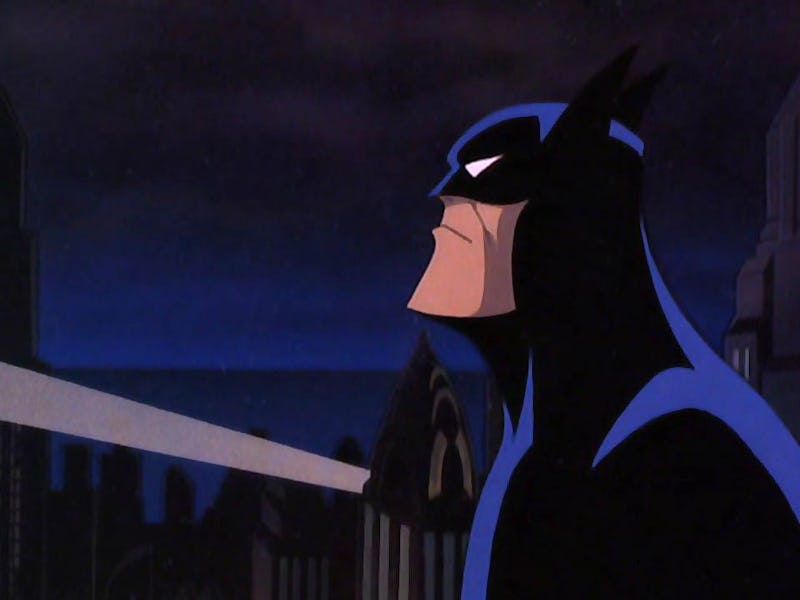6 Times 'Batman: The Animated Series' Was the Best Batman Ever
How one show redefined the Dark Knight forever.

25 years have passed since Batman: The Animated Series debuted in 1992, arguably changing the landscape for comic book superhero storytelling for good. Though we’ve seen various iterations of the Dark Knight in animated, live-action, and video game form since then, few come close to matching The Animated Series in quality and universal acclaim.
Developed by Bruce Timm and Eric Radomski, Batman: The Animated Series marked a significant departure away from the character’s previous campy tones on TV and instead crafted a darker, more complex version of Batman tailored towards a modern audience. Borrowing from film noir allowed the series to be serious and artistic while also showcasing Batman’s odd assortment of villains.
Batman: The Animated Series did more to distinguish Batman as a hero worth paying attention to amidst a growing pantheon of godlike heroes than any other version of the character. The fact that it did so while including the Dark Knight’s goofy and often fantastically superpowered enemies made it that much more impressive.
The series originally aired weekday afternoons at 4:30 p.m., catering towards a younger-aged audience, but it also had a brief stint during Sunday evening primetime, which only proved that Batman: The Animated Series has always been a series beloved by fans of all ages.
Here are six times that Batman: The Animated Series proved itself as the best depiction of Batman ever:
1. Opening Sequence
One of the best things that Batman: The Animated Series had going for it was an impressive orchestral score done by Shirley Walker. She had experience with feature-length motion pictures and even the live-action TV adaptation of The Flash that aired in the ‘90s.
Danny Elfman is credited on the iconic “Main Title” track that plays over the opening credits, but almost the entirety of the remaining score was composed by Walker. The music did more to establish the darker, more heroic tone of the series than anything else, and it’s largely why many still regarded
Harley Quinn was born in 'Batman: The Animated Series.'
2. The Birth of Harley Quinn
Harley Quinn is having a moment right now. Margot Robbie starred as Harley Quinn in Suicide Squad and the animated Batman and Harley Quinn also focused on the character. She’s also taken a central role in games like Injustice 2. The clownish love interest to The Joker has outshined her beloved “mistah jay” in these properties. It’s sometimes easy to forget that Harley actually made her debut in Batman: The Animated Series in September 1992 during the episode “Joker’s Favor,” before making her way into comics and the various other mediums.
What was initially a one-off walk-on role for actress Arleen Sorkin expanded astronomically over the last 25 years.
3. Showcasing Mark Hamill’s Version of The Joker
Other than playing the hero in the original and wildly successful Star Wars trilogy, Mark Hamill’s next-greatest role is undoubtedly in lending his voice to Batman’s principal villain: The Joker.
The character has seen a number of different iterations in various films — including Heath Ledger’s renowned turn as the character — but still, Hamill’s Joker remains the definitive version of the Clown Prince of Crime.
When Batman fights a Man-Bat, he's also fighting his own sense of humanity.
4. Including Batman’s Weirder, Darker Villains Like the Man-Bat
The very first episode of The Animated Series, “On Leather Wings,” forcibly differentiated the show from what fans typically expected of the Dark Knight. Batman’s relationship with the police isn’t very positive, and the very first story sees him grapple with the horrific Man-Bat. It establishes The Animated Series as a darker kind of superhero story that strikes a pitch perfect tone between noir and gothic without falling into the more recent “darker, grittier, more boring” trend.
Somehow, Man-Bat works in this universe, but it never could in the DCEU. The Animated Series leans heavily into themes and grapples with Bruce’s sense of humanity. Nowhere does that inner conflict become a greater focus than when he literally grapples with a physical manifestation of his own fears in the Man-Bat.
Mr. Freeze became a horrifying new version of himself in 'The Animated Series.'
5. The Animated Series Fixed Mr. Freeze
“Heart of Ice” offers up a less campy and much scarier costume design for Mr. Freeze while also providing a tragic backstory for the character. In this way, Batman: The Animated Series fixed a weird Batman villain that nobody really cared about by rebuilding him entirely. Mr. Freeze went from the weird fishbowl-headed guy with an ice gun to a frigid, ruthless Terminator. (It’s all too fitting that Arnold Schwarzenegger would play the character in Batman & Robin.)
The Animated Series may have created Harley Quinn, but it did almost as much in its complete rebuild of Mr. Freeze.
Could Clayface be Batman's most powerful foe?
6. Establishing Clayface as a Fearsome Villain
Few villains from Batman: The Animated Series remain more prominent all these years later than the horrific Clayface. Like many of Batman’s villains, Matt Hagen has a tragic story that turned him into an amorphous, humanoid clay-person during the “Feat of Clay” two-parter.
The creativity behind the character’s animation only enhances how fearsome he is as an adversary, serving as a reminder to Batman’s own physical limitations. Like the Man-Bat, Clayface is a harder villain to adapt to the big screen, but the way he works in the dark, fantastical universe of DC Animated films represents the Batman franchise at its very best.
Must Read: “Power Ranking The Best ‘Batman: The Animated Series’ Episodes”